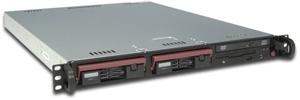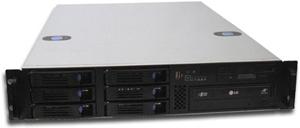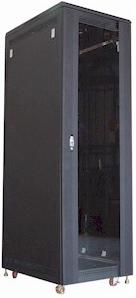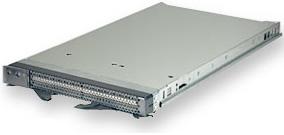Unlike tower servers, offices that use rack servers which traditionally come in 1U, 2U, 3U, 4U or 6U are installed in racks. The numbers that give names to the rack mounted servers precisely indicate the number of Us they occupy in the racks. The 1U server occupy a single 1U bay, the 2U occupy two and the 4U occupy four, while a rack of standard size has up to 42U:

1U rack server - note the hot swapable hard drives
The servers in 1U format are preferred by companies for use in hosting and data, because they are very compact (only 4.4 cm high), which lets you install a large number of servers per rack. The main limitations of this format is the limitations with regard to ventilation (due to the small inner space), impeding the use of processors with high energy consumption and the need to use coolers and special fans, which all run at an extra cost. Besides the basic components, spare space in general to install 2 or 4 hard drives of 3.5 "(according to the provision of other components) and a single expansion card, installed horizontally, with the help of a Riser.

2U rack server
Then there are the 2U servers. They use "normal" power sources and coolers and therefore end up being a little cheaper. The bigger internal space makes the format more suitable for 2U servers with two or more processors, or processors that use high consumption. The height is not enough to install expansion cards upright, as in tower servers, but you can use a Riser (as in the case of 1U), or use half-height cards (the lower plates, which have half the height of normal plates).

Server rack
Finally, we have the biggest servers, which use 3U or 4U. There are 6U servers, but they are rare: this format is typically used by the disk arrays and chassis for blade servers (see the topic below). Using a 3U server or larger completely eliminates the problems with space, allowing the expansion cards to be fit in vertically and a large number of removable hard drives installed in bays, but causes the server to occupy more space in the rack, which increases the cost to the host of the datacenter, where you would pay an extra fee per pen used.

IBM JS20 Blade Server
Another format that is becoming increasingly popular are the blade servers (blade comes from the word "blade", indicating the small format), an ingenious idea to further increase the density of servers and allow the sharing of common components in the datacenter, as power supplies and optical disks.
The idea is that instead of having 10 1U servers, with 10 sources (or 20, if sources were used redundant), 20 network cables (each server typically uses two cables, one for the network and another for management or redundancy), as well as power cables, cables used by KVM and so on, you can use a single Chassis, with an equivalent number of blade servers.
Each blade is a complete server with its independent processor, memory, network card and disks. Its small size, the blade servers typically use low-power processors and hard drives of 2.5". At the beginning, it was the common use of processors from Transmeta and VIA, but they ended up being almost completely replaced by Intel and AMD multiple cores processors which are much faster, but still relatively economics. In the case of hard drives, the disks of 2.5 "are favorites for providing lower access times (but lose with respect to transfer rate), in addition to electric consumption.
Thought not all blade system are created equally. Therefore if you are planning to jump into the blade campaign you should find the best fit blade system for your case. Check out the below comparisons which will help you compare between them:
By Julie Cole, a member of ITComparison.com Hardware team and write for the Virtualization Team Blog.
More Networking Basics:
• What is an Ethernet Crossover Cable?
• Home and Small Office Networking Guide
• Best CompTIA Network+ Certification Exam Preparation Materials
• A Complete Explanation of Cloud Computing
• Network+ Certification Exam Tutorial - How And When To Use Virtual LANs (VLANs)
• Computer Networking Basics
• Satellite Broadband Internet Service
• Virtualization For Dummies Cheat Sheet
• Servers - Racks, Blades and Towers
• Computer Number Systems Made Simple

